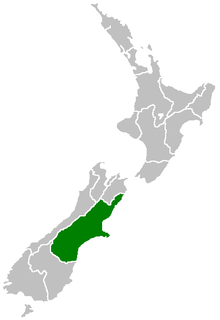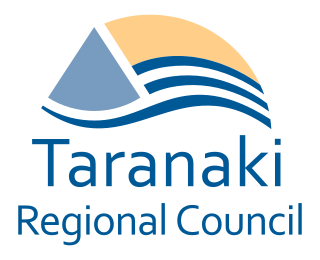
Wellington is the capital and second most populous urban area of New Zealand, with 418,500 residents. It is located at the south-western tip of the North Island, between Cook Strait and the Remutaka Range. Wellington is the major population centre of the southern North Island, and is the administrative centre of the Wellington Region, which also includes the Kapiti Coast and Wairarapa. It is the world's southernmost capital of a sovereign state. Wellington features a temperate maritime climate, and is the world's windiest city by average wind speed.

Canterbury is a region of New Zealand, located in the central-eastern South Island. The region covers an area of 44,508 square kilometres (17,185 sq mi), and is home to a population of 624,000.

Hawke's Bay Region is a region of New Zealand on the east coast of the North Island. It is governed by Hawke's Bay Regional Council, which sits in the city of Napier. The region's name derives from Hawke Bay, which was named by Captain James Cook in honour of Admiral Edward Hawke.

The Wellington Region is a local government region of New Zealand that occupies the southern end of the North Island. The region covers an area of 8,049 square kilometres (3,108 sq mi), and is home to a population of 521,500.

Taranaki is a region in the west of New Zealand's North Island. It is named after its main geographical feature, the stratovolcano of Mount Taranaki.

Palmerston North is a city in the North Island of New Zealand and the seat of the Manawatu-Wanganui region. Located in the eastern Manawatu Plains, the city is near the north bank of the Manawatu River, 35 km (22 mi) from the river's mouth, and 12 km (7 mi) from the end of the Manawatu Gorge, about 140 km (87 mi) north of the capital, Wellington. Palmerston North is the country's seventh-largest city and eighth-largest urban area, with an urban population of 86,600.

The Northland Region is the northernmost of New Zealand's 16 local government regions. New Zealanders often call it the Far North or, because of its mild climate, the Winterless North. The main population centre is the city of Whangarei, and the largest town is Kerikeri.

The North Shore is part of the urban area of Auckland, New Zealand, located to the north of the Waitematā Harbour.

Te Awamutu is a town in the Waikato region in the North Island of New Zealand. It is the council seat of the Waipa District and serves as a service town for the farming communities which surround it. Te Awamutu is located some 30 kilometres (19 mi) south of Hamilton on State Highway 3, one of the two main routes south from Auckland and Hamilton.

Waikanae is a town on New Zealand's Kapiti Coast. The name is a Māori word meaning "waters" (wai) "of the yellow-eyed mullet".

New Zealanders, colloquially known as Kiwis, are people associated with New Zealand, sharing a common history, culture, and language. People of various ethnicities and national origins are citizens of New Zealand, governed by its nationality law.
European New Zealanders are New Zealanders of European descent. Most European New Zealanders are of British and Irish ancestry, with smaller percentages of other European ancestries such as Croatians, Germans, Greeks, Poles, French, Dutch, Scandinavians and South Slavs. The term European New Zealander encompasses white people who are of indirect European descent, including Americans, Canadians, South Africans and Australians.

New Zealand is a sovereign island country in the southwestern Pacific Ocean. The country geographically comprises two main landmasses—the North Island, and the South Island —and around 600 smaller islands. New Zealand is situated some 2,000 kilometres (1,200 mi) east of Australia across the Tasman Sea and roughly 1,000 kilometres (600 mi) south of the Pacific island areas of New Caledonia, Fiji, and Tonga. Because of its remoteness, it was one of the last lands to be settled by humans. During its long period of isolation, New Zealand developed a distinct biodiversity of animal, fungal, and plant life. The country's varied topography and its sharp mountain peaks, such as the Southern Alps, owe much to the tectonic uplift of land and volcanic eruptions. New Zealand's capital city is Wellington, while its most populous city is Auckland.
Religion in New Zealand encompasses a wide range of groups and beliefs. Christianity is the most common religion with almost half of the population at the 2013 New Zealand census declaring an affiliation. Around six percent of the population is affiliated with non-Christian religions, with Hinduism being the largest at over two percent, while 42 percent of New Zealanders stated they had no religion in the most recent census, and 4 percent made no declaration.
American New Zealanders are New Zealand citizens who are of American descent including immigrants or American-born citizens and residents. American New Zealanders constitute a small minority of New Zealand's population.

Rangitāne is a Māori iwi (tribe). Their rohe (territory) is in the Manawatū, Horowhenua, Wairarapa and Marlborough areas of New Zealand.

Auckland is a city in the North Island of New Zealand. The most populous urban area in the country, Auckland has an urban population of around 1,628,900. It is located in the Auckland Region—the area governed by Auckland Council—which includes outlying rural areas and the islands of the Hauraki Gulf, resulting in a total population of 1,695,900. Auckland is a diverse, multicultural and cosmopolitan city, home to the largest Polynesian population in the world. A Māori-language name for Auckland is Tāmaki or Tāmaki-makau-rau, meaning "Tāmaki with a hundred lovers", in reference to the desirability of its fertile land at the hub of waterways in all directions.

The Māori are the indigenous Polynesian people of New Zealand. Māori originated with settlers from eastern Polynesia, who arrived in New Zealand in several waves of canoe voyages some time between 1250 and 1300. Over several centuries in isolation, the Polynesian settlers developed a unique culture, with their own language, a rich mythology, and distinctive crafts and performing arts. Early Māori formed tribal groups based on eastern Polynesian social customs and organisation. Horticulture flourished using plants they introduced; later, a prominent warrior culture emerged.


















